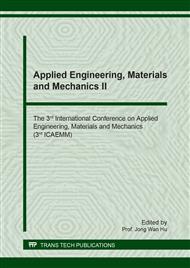p.40
p.46
p.51
p.56
p.62
p.67
p.72
p.77
p.82
Preparation and Electrical Properties of Activated Carbon Grafted with Polyaniline Nanofiber
Abstract:
Activated carbon (AC) grafted with polyaniline (PANi) was prepared. Firstly, surface modifications of AC were carried out using sulfuric acid/nitric acid and followed by sodium hydrosulfite/ammonia, resulting in nitro group functionalized AC and free amine group functionalized AC, respectively. Functionalized groups were confirmed by FTIR analysis. Then, PANi was deposited onto modified AC surface through oxidation polymerization of aniline using ammonium persulfate as an initiator. After that, AC-NO2/PANi composites (1:0.25 and 1:0.5) and AC-NH2-g-PANi (1:0.25 and 1:0.5) were prepared. SEM images revealed that PANi was successfully deposited onto modified AC surface due to polar-polar interaction (in case of AC-NO2) and grafting reaction (in case of AC-NH2). Interestingly, at low aniline concentration, PANi nanofiber was produced, resulting in PANi having the highest surface area. As a result, the PANi nanofiber on porous activated carbon electrode exhibited high EDL capacitance value of 242 F/g. In contrast, PANi granular form exhibited significantly decreased in EDL capacitance value.
Info:
Periodical:
Pages:
62-66
Citation:
Online since:
July 2018
Authors:
Price:
Сopyright:
© 2018 Trans Tech Publications Ltd. All Rights Reserved
Share:
Citation:


